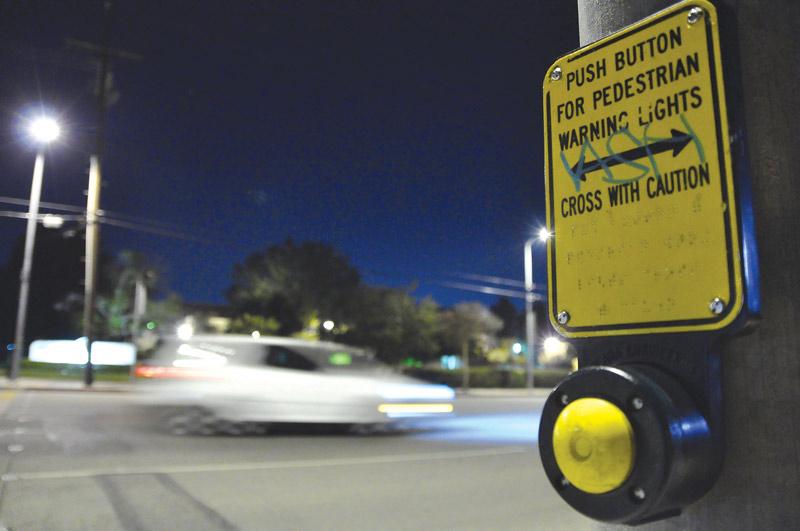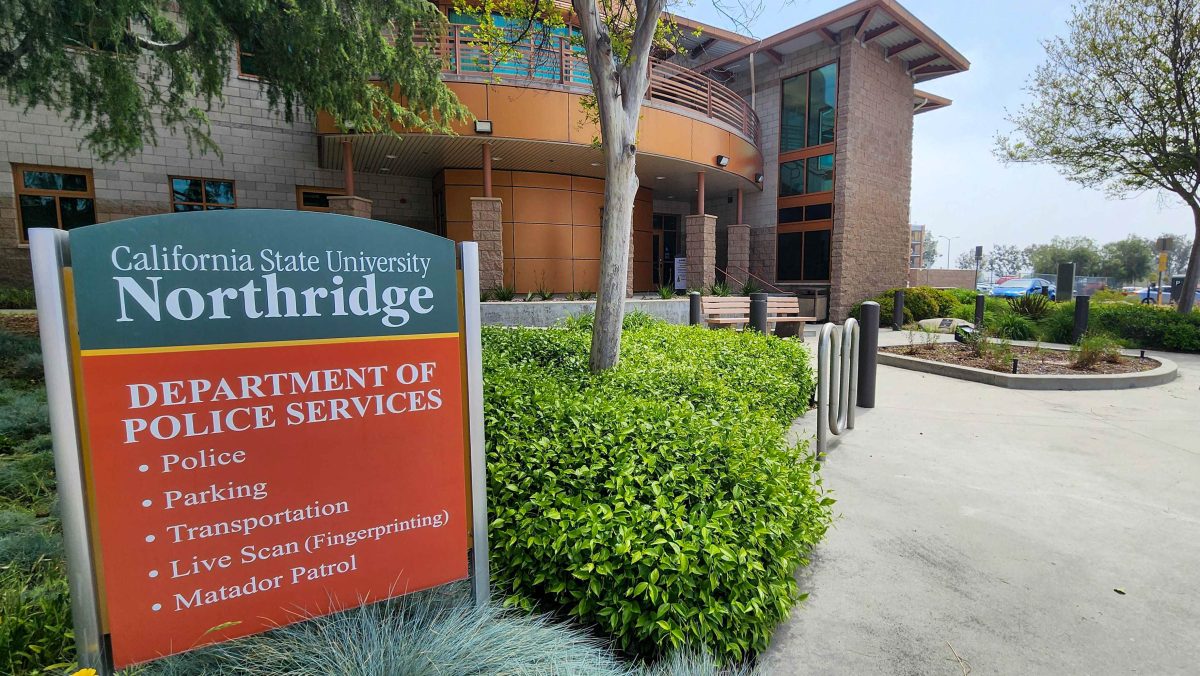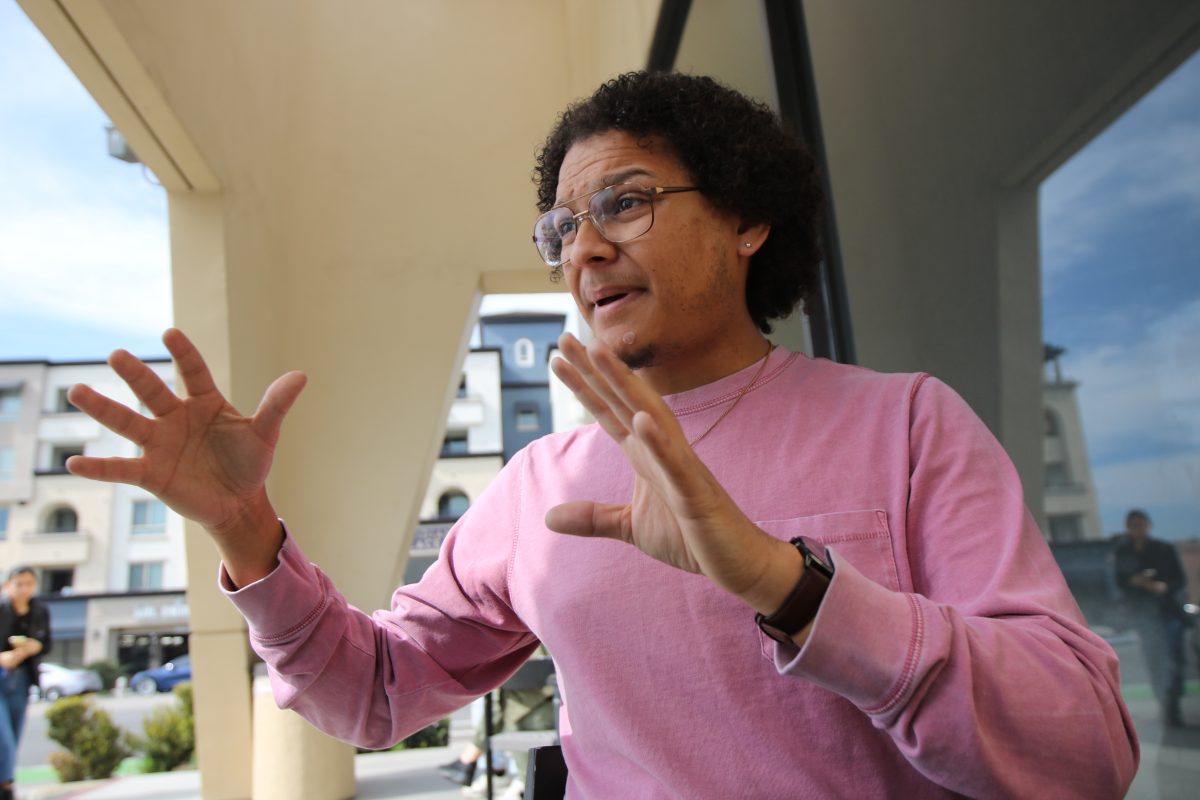
Pedestrian Safety at CSUN Part 3 of 5
This article was reported by :
Megan Blumenthal
Danielle Directo
Brittany Glover
Alexis Lipnicki
Sandra Parada
Mike Tersigni
Alex Viray
Tade Williams
Written by:
Danielle Directo
Devonshire Valley Traffic Det. William Bustos said the department conducts enforcement in specific areas after analyzing their statistics to determine where pedestrian accidents and fatalities are on the rise.
“We found out that most pedestrians are abiding by the law and they’re crossing the intersections and the marked crosswalks, and the drivers are just not paying attention or they’re looking at the pedestrians and not yielding,” he said.
Police also conducted a similar safety sting at Ranchito Boulevard and Victory Avenue in Van Nuys, Bustos added.
“The location does play a role because there are a lot of pedestrians,” Bustos said. “In this particular case, it happens to be a university.”
Bustos said he often hears many complaints from the community.
“Sometimes people say, ‘We need a light here,’ and that’s a common (complaint),” Bustos said. “The engineers from the city of L.A. and (Department of Transportation)…do their own studies and projects and so on,” he said, and the police department is responsible for enforcement of the law, not street maintenance.
“Unfortunately…if people would just cross the street the way they’re supposed to, they wouldn’t need a light,” he added.
Seventeen-year-old Andreas Karras-Lazaris, the son of Intensive English Program (IEP) Academic Director Bessie Karras-Lazaris, heard a similar explanation in his efforts to make CSUN-area sidewalks safer.
Andreas became friends with Yao Lu, the Chinese exchange student who was struck by a car on Reseda Boulevard and Vincennes Street last November, when he would stop by his mother’s office at CSUN’s IEP.
The Chaminade College Preparatory High senior had been in contact with city officials and police to bring attention to the dangerous crosswalks around the university.
“He’s a little frustrated,” because he felt his concerns were falling on deaf ears, said Karras-Lazaris, as she sat in her office. Her son was told by authorities that “they were ‘working on it’.” Finally, “a case number was opened for him,” said Karras-Lazaris, but her son hasn’t heard much else.
Pedestrian safety – or lack thereof – isn’t just an issue off-campus.
David Arias, a 22-year-old journalism student from Sherman Oaks, was running late to class when he was hit on Etiwanda Avenue, which runs through the university, eight months ago.
He suffered a bruised knee, Arias said in a phone interview, but he didn’t report the incident or seek help. He described the driver of the sports utility vehicle as a woman who was talking on her cell phone and failed to observe the stop sign and proceeded to run her vehicle through additional crossings without stopping as required.
Since he was running late, he continued on his way to class and planned on filing a report later, Arias said.
That incident, however, was not his first. Arias was also struck last November while crossing the intersection of Plummer Street and Zelzah Avenue when a driver made a right turn and failed to see him. His right foot was run over, but fortunately, he said, he sustained no major injuries.
Ultimately, Arias said he ended up not filing the reports, saying too much time had passed and he was no longer certain about the details of the accidents. Arias said he didn’t think he had a chance filing an accurate report because the SUV in the last incident had run several stop signs and was long gone.
Research by student journalists shows the Los Angeles Police Department (LAPD) Devonshire division’s CSUN-area accidents aren’t simply touch-and-go incidents where pedestrians like Arias were lucky enough not to sustain major injuries.
Of the 2006-08 accidents involving motor vehicles and pedestrians or bicyclists that occurred around the university, about 45 percent of people showed visible injuries, 41 percent suffered pain and eight percent suffered broken bones. Only about 4 percent of those in the accidents walked away without injuries or reported feeling no pain, and one accident victim, 19-year-old CSUN student Johoney Lobos, died.
But motorists and pedestrians alike are at fault for accidents, research found. Half of the motor vehicle and pedestrian or bicycle accidents reported near CSUN last year were determined to be the fault of drivers, student journalists found.
In 2007, 44 percent of accidents near the university reported to police were the fault of drivers.
According to CSUN police records, out of the seven motor vehicle and pedestrian or bicycle accidents that occurred on campus in 2007 and 2008, four were the result of drivers either failing to yield or stop at the crosswalk. One was determined to be the fault of a cyclist who crossed while conditions were unsafe, and two incidents were undetermined.
The university launched its own program aimed at addressing pedestrian safety. During a sting in mid-March, 80 citations were issued on the college campus for offenses including violations in using cell phones, not obeying stop signs or ‘no turn’ signs or disregarding crosswalks, said Christina Villalobos, special assistant to the CSUN chief of police.
But CSUN police have a limited jurisdiction, said Villalobos, and major streets surrounding the university, such as Nordhoff Street and Reseda Boulevard, are patrolled by the LAPD’s Valley Bureau, which includes the Devonshire division.
One of those LAPD-patrolled major streets includes Zelzah Avenue.
Despite the opposition from neighborhood councils and residents, The Los Angeles City Council approved a motion to raise speed limits on Zelzah Avenue between Chatsworth and Nordhoff streets, a busy intersection that borders CSUN’s east side and on which Northridge Academy High School and Granada Hills High School sit. The speed limit was raised by 5 mph to 40 mph.
Rita Robinson, general manager of LADOT – the agency that conducts surveys to determine what needs to be changed on city streets – said at a Transportation Committee meeting that she recognized the system doesn’t require the agency to inform or present the projects and proposals to neighborhood councils.
Current laws dictate that in order to use radar or laser traffic enforcement, the speed limits must be updated to reflect drivers’ average speeds.
Anne Glavin, chief of CSUN police, calls the process “a double-edged sword.”
“It’s…one of those catch-22 situations, where we really don’t want the speed to go up,” said Glavin in a phone interview.
She added that the Northridge East Neighborhood Council (NENC), of which CSUN and the area of Northridge east of Reseda Boulevard are included in its boundaries, did endorse the speed limit increase, though “they said it was not their preference to do it.”
In their April 7 meeting, despite their almost yearlong effort to fight the Zelzah speed limit increase, the council said it was “prepared to accept, with reservation, the LADOT’s recommendations” provided that local law enforcement “work diligently with NENC and other neighborhood councils and community members…and minimize excessive speed, traffic, injuries and fatalities” in the area, according to meeting records.
Glavin said in a phone interview that the NENC was worried “that if the speed (increased), more people will go faster.” Residents were concerned that “not only will (drivers) go the speed limit, but they’ll go over it.”
Neighborhood councils merely serve as advisory boards to the city, and ultimately, the Transportation Committee, which receives the LADOT’s surveys, has the final say in determining speed limits.





